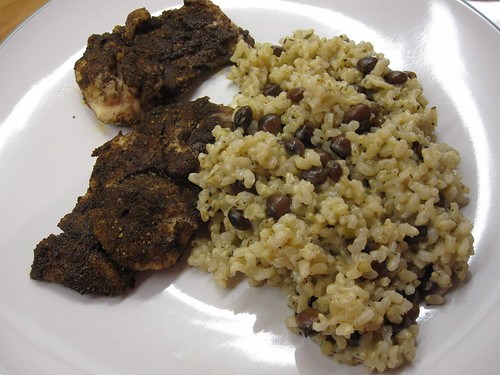
On my last day at work at the end of February, I finished a bit earlier and decided to do a grand tour of the various supermarkets available on my way home. For starters, I wanted to get some more of Lundulph's favourite alcohol-free beer, which is hard to get hold of and I had a reliable source near the office. And I also needed to get more canned beans, which has become Lundulph's staple now that he's trying to reduce his meat intake.
Sadly, there was no beer to be had, in fact, the labels had even been removed. But next to the booze section was the Caribbean section and I wandered in to have a gander. What drew my attention were colourful cans of gungo peas in salted water, so I had to buy a couple to try out.
A quick search on the internet yielded that gungo peas are also known as pigeon peas and are popular in the Caribbean dish "rice and peas". I decided on this recipe. Some further recipe searches indicated that this is very nice with jerk chicken and I particularly liked this one from John Torode, but since barbecue season is way off yet and the recipe requires a lot of prep, I decided on the super-easy alternative of jerk seasoning in a jar instead.
Ingredients
400 g can of gungo peas incl liquid
400 ml can of coconut milk
1.5 dl water
3 dl shortgrain brown rice
2 cloves garlic
2 salad onions
1 tsp dried thyme
salt and pepper to taste
5 chicken thighs without bone
2 - 3 tbsp jerk seasoning
Method
- Place the gungo peas including their liquid in a large pot, along with the coconut milk, water and rice.
- Peel the garlic and press into the pot. Trim, wash and slice the salad onions(~1 cm) and add to the pot.
- Add the thyme, salt and pepper and bring to the boil.
- Cover and simmer until the rice is done, about 30 minutes, and the liquid has been absorbed.
- Pre-heat the oven to 200 °C and pat the chicken thighs dry. Then coat generously on both sides with jerk seasoning and place on a roasting rack.
- Bake in the oven for 20 minutes until the meat has cooked through.
- Fluff up the rice before serving.
The rice and peas turned out to be a disappointment for both Lundulph and myself. Maybe it is down to the fact that I tried to scale down the recipe a bit or that I had way too much liquid, so had to drain it off. I've tried to make an adjustment in the amounts above for this. It just didn't taste of much. I did save the liquid and used as gravy when I re-heated the rice at later meals and I suspect it would be rather nice with oven-baked mushrooms.
Lundulph really liked the jerk chicken though. It had quite a kick to it, it seems. I don't like chicken thighs, so I didn't try them, but he seemed well pleased with the result.
I'll need to see if I can try the rice and peas at a Caribbean restaurant, to see how they make it. And there's also John Torode's recipe to try.